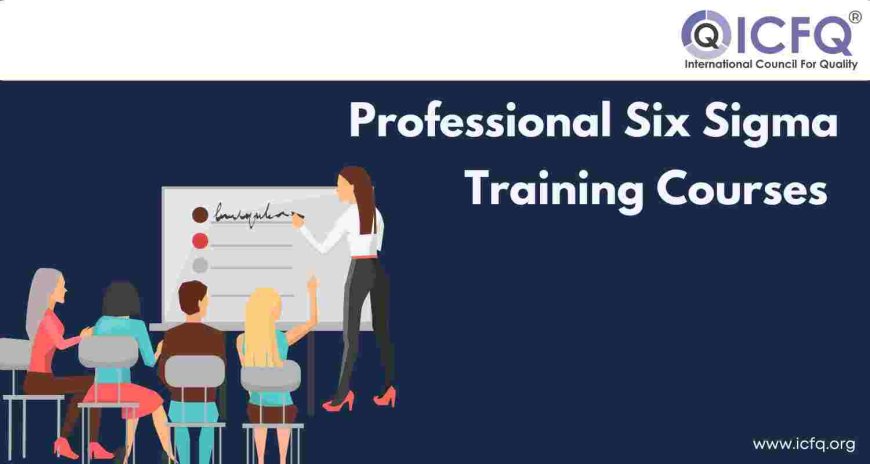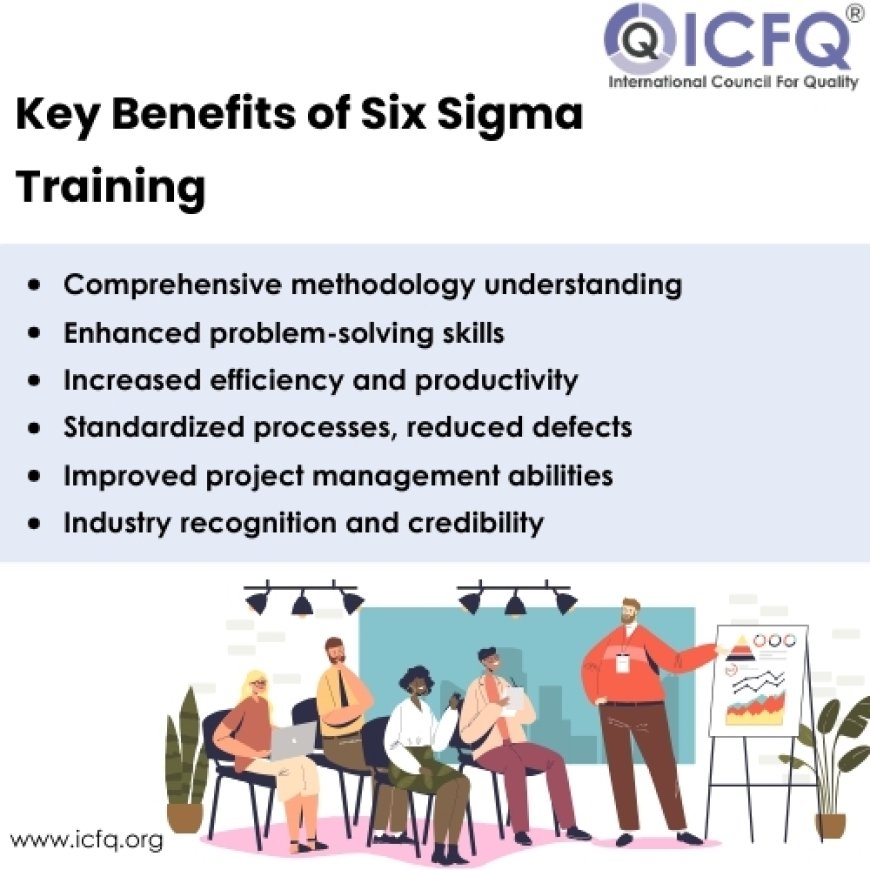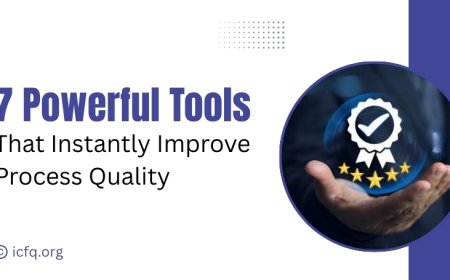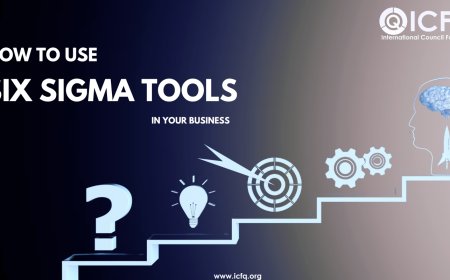Professional Six Sigma Training Courses
Master process improvement with Professional Six Sigma Training Courses. Gain essential skills for efficiency and quality enhancement in your career. Enroll now!

Six Sigma training teaches professionals how to find and fix problems, which helps to enhance quality and make customers happier. Six Sigma courses are available for different skill levels, from basic to advanced certifications such as Six Sigma Green Belt and Six Sigma Black Belt. These courses cover Lean Six Sigma principles, combining lean manufacturing techniques with statistics to get the best results in improving processes. Whether you prefer learning in a classroom or online, Six Sigma training offers flexibility for busy professionals who want to improve their skills.
The demand for Six Sigma certification is growing across many industries because it's proven to save money and make operations run better. Companies around the world need certified Six Sigma experts to lead projects that show real results, making it a valuable skill for advancing in quality management and process improvement careers. Explore the various opportunities provided by Six Sigma training courses to unlock your potential in helping organizations succeed through continual improvement and making decisions based on data. Whether you're new to Six Sigma or want to earn higher certifications, investing in Six Sigma training prepares you to meet today's business challenges.
Understanding Six Sigma Training Courses: A Complete Guide
The demand for professionals skilled in improving processes, like Six Sigma training, is growing. Six Sigma training teaches methods to make operations more efficient, reduce errors, and improve processes in various industries. Whether you're starting with aSix Sigma Yellow Belt to learn the basics or aiming for a Six Sigma Master Black Belt for leadership roles, it's important to know what each certification offers.
Six Sigma training includes different certifications for different career stages and goals. Beginners often begin with Yellow Belt training to learn basic methods and tools. Those looking to lead projects and drive change within organizations pursue the Six Sigma Black Belt certification, which provides advanced training in statistical analysis and project management. Professionals interested in combining Lean principles with Six Sigma can opt for Six Sigma Lean Certification to better streamline processes and reduce waste. By getting certified in Six Sigma training, individuals show their dedication to improving quality and efficiency in today's workplaces focused on data and efficiency. Whether you want to enhance your credentials or improve team performance, Six Sigma training gives you the skills to continually improve and achieve tangible results.
Challenges in Choosing the Right Professional Six Sigma Training Course
Choosing the right Six Sigma training course can be tough due to several main challenges:
1. Different Course Options: There are many Six Sigma training programs available, from basic to advanced levels, and each claims to be the best.
2. Accreditation and Certification: Making sure the course is certified by respected organizations like ASQ or IASSC is important for industry recognition and career growth.
3. Flexibility and How It's Taught: Finding a course that fits your schedule and how you like to learn—whether online, in-person, or a mix—is crucial for effective learning.
4. Quality of Content and Teachers: Figuring out if the course content is good, relevant to current industry practices, and if the instructors are qualified can be hard but important.
5. Cost: Balancing the cost of training with what you get from it and the reputation of the course provider is important to avoid spending too much or choosing a lower-quality option.
To handle these challenges, you should do thorough research, read reviews, and maybe ask professionals for advice. Picking the right Six Sigma training can make a big difference in how your skills develop and your career prospects in quality management. For more detailed help with choosing a Six Sigma training course, visit our website to find lots of useful resources about Six Sigma training.
Which Six Sigma Training Course Is Right for You?
1. Know Your Skill Level:
-
Figure out where you stand in terms of Six Sigma knowledge and experience.
-
Decide if you're starting and need basic training or if you're more experienced and looking for advanced courses.
2. Set Your Career Goals:
-
Consider how Six Sigma training fits into your career plans.
-
Determine if you need training tailored to specific industries or leadership roles.
3. Check Course Content:
-
Look at what different Six Sigma training courses cover.
-
Compare what topics they include, how in-depth they go, and how practical they are.
4. Look for Accreditation and Recognition:
-
Make sure the training provider is accredited by well-known Six Sigma organizations.
-
Check if the certification you'll get after completing the course is respected in the industry.
5. Choose Your Learning Style:
-
Decide how you want to learn (online, in-person, or a mix).
-
Think about how flexible the scheduling is and how easy it is to get course materials.
6. Read Reviews and Get Recommendations:
-
Read what other people who took the course thought about it.
-
Ask people you know who work in the same field if they have any recommendations.
7. Think About Cost and Value:
-
Compare how much different Six Sigma training courses cost and what you get for that money.
-
Look for extra things like chances to meet people in your industry, help with your career, or more stuff to learn.
8. Check Out Requirements:
-
Make sure you meet all the things you need to sign up for the course.
-
See if there are special skills or education you need to do well in the course.
9. Look at Support and Extras:
-
See how much help you'll get while you're taking the course and after it ends (like talking to teachers, online groups, or other ways to learn more).
-
Think about what else comes with the course, like practice tests, stories about things that happened, or stuff you can use later.
10. Match Your Learning Style:
-
Pick a course that fits how you like to learn (seeing things, hearing things, or doing things).
-
Make sure the way the course is set up and how the teachers teach makes sense for how you learn best.
Choosing the Best Six Sigma Training Course for Professionals
Selecting the right Six Sigma training course is crucial for professionals looking to boost their skills and career opportunities. Here are key factors to consider when picking the ideal Six Sigma training:
1. Accreditation and Certifications: Look for courses accredited by respected organizations like IASSC or ASQ. These certifications ensure that the training meets industry standards and boosts your credibility in Six Sigma methodologies.
2. Training Formats and Flexibility: Consider your preferred learning style and schedule. Courses are available in-person, online, or as a blend of both. Choose one that fits your lifestyle and allows flexibility in completing coursework.
3. Curriculum Depth and Coverage: Review the curriculum thoroughly. A good Six Sigma course should cover the DMAIC (Define, Measure, Analyze, Improve, Control) method, statistical tools, and practical applications across various industries.
4. Trainer Expertise and Support: Evaluate the qualifications and experience of instructors. Look for trainers who are certified Black Belts or Master Black Belts with hands-on experience in implementing Six Sigma projects.

5. Reviews and Reputation: Read reviews and testimonials from past participants. This can offer insights into the course's effectiveness, the support provided, and the overall learning experience in Six Sigma training.
6. Cost and Value: Compare costs among different providers. While affordability matters, prioritize the value and return on investment. Investing in quality Six Sigma training can lead to better job prospects and salary growth.
7. Additional Resources and Assistance: Check for extra resources such as study materials, access to online forums, and post-training support. These resources can enhance your learning and application of Six Sigma principles.
8. Career Growth Opportunities: Consider how the course aligns with your career goals. Look for training that offers networking chances, job placement aid, or advanced certification paths to advance your career in Six Sigma.
By carefully considering these factors, you can choose a Six Sigma training course that equips you with vital skills and enhances your professional status in the field. For more detailed information on Six Sigma training options, visit ICFQ's website. This approach ensures you make an informed decision that aligns with your career goals and enhances your expertise in Six Sigma methodologies.




























